Unit - 3
Project Resources and Site Planning
Objectives of Materials Management
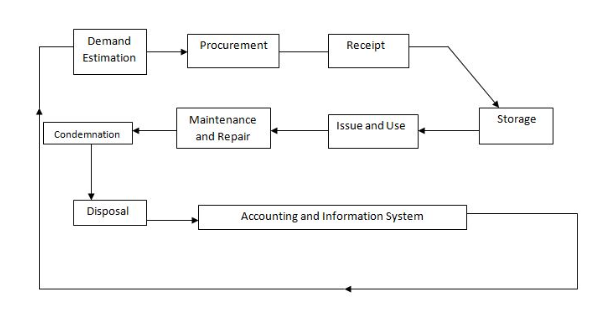
To meet the primary objectives, the primary functions of the materials management are given as follows:
Materials Requirements Planning (MRP)
Purchasing
Inventories
The zero inventories are the ideal planning. There are three types of inventories.
Inventory at different levels is necessary to make sure about the availability of all these types of materials and goods and their proper flow from one facility to another at different levels of production centers in a manufacturing concern.
Ascertaining and Maintaining the Flow and Supply of Materials
The distribution of materials requisitioned by the various production centers and other departments must be ascertained and the materials management department must maintain its flow and continuity of supply.
The management has to maintain continuity in production to meet this uncertainty in demand and control the situation by proper flow of materials supply and distribution at various production facilities and other departments as per changes in production quantity.
Quality Control of Materials
The quality of the product manufactured by the organization depends upon the quality of the materials used to manufacture that product. It is a very important and necessary function of materials management to purchase the right quality of materials.
The inspection, quality control, simplification, specification, and standardization are the activities which are to be followed for the measurement of quality of the materials.
Departmental Efficiency
The objective of this function is to ensure the efficiency of the system adopted. Management Information System (MIS) and feedback control at every stage of working must be adopted to control and make the management and employee work as efficiently as possible to achieve the best results.
There can be number of secondary functions.
Standards define the quality, reduction in sizes and variety, interchangeability of parts and products. It ensures efficient utilization of materials and reduces wastages.
The objective of this function will be to produce standard product reducing the overall cost of the product.
2. Design and Development of the Product
The variety in product and functionality are the important factors to promote the sales of a product. The new techniques of designing a product using Computer Aided Design (CAD) has made possible to develop variety of products at faster rate.
3. Make and Buy Decisions
These types of decisions are the policy decisions of the management. The capacity of the organization and the various facility developed by the organization to manufacture various items is the main objective of every organization.
4. Coding and Classification of Materials
5. Forecasting and Planning Materials
d. In case of fluctuating demands, there can be uncertainties in supply as well. This can be overcome by maintaining the proper quantity in inventory of short supply materials at proper time.
Key Takeaways:
Material Requirement
Raising of an Indent
Once need for a specific item or service has been established the next step shall be to transmit the need to the purchasing people for processing at their end. It may require certain paper work or electronic media to do this job.
Transmission of need to Purchase department is usually done through any one of the following three forms:
2. Traveling Purchase Requisition (TPR)
Since TPRs are raised for Inventory items, the need of the item arises on the basis of certain forecasting methods employed by the Inventory control section. Popular methods are Periodic Review system, Fixed quantity system or Reorder point system
3. Bill of Materials
|
|
|
Receipts and Inspection
Receiving of Materials
In small and medium-sized manufacturing concerns, functions of receipt and inspection of materials are to be performed by the stores department or the store-keeper. But in case of large manufacturing concerns, generally, a separate Receiving Department is set up. The Receiving Department has the following functions to perform:
Inspection
When materials are received by the Receiving Department, they are unpacked and compared with the materials ordered for with the help of the purchase order.
Format of Inspection Note
The specimen of the Inspection Note is given below:
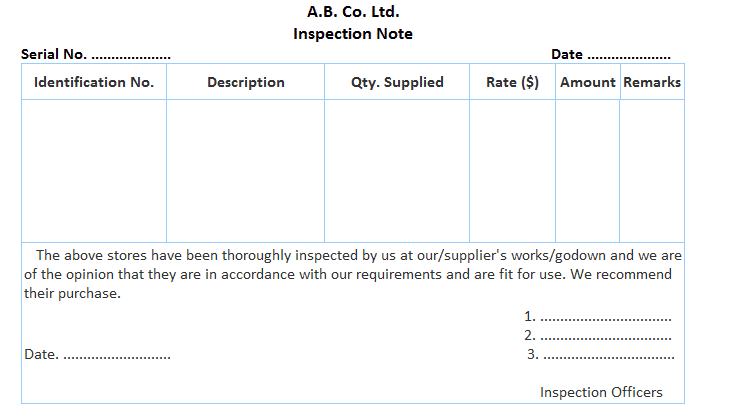
Rejection Note
If the materials received are not found to be in accordance to the purchase order or fit for use, the inspecting staff rejects them for return to the supplier. For this purpose, a document known as Rejection Note is prepared.
Format Rejection Note
The specimen of the Rejection Note is given below:
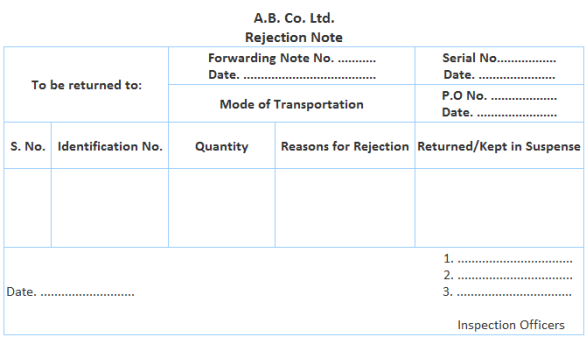
Material Receipt Book
It is the prime book used for the purpose of store accounting and keeps a date-wise record of the materials received in the stores. The Material Receipt Book provides the following information:
Format Material Receipt Book
The specimen of Material Receipt Book is given below:

Material Received Note (Or Goods Received Note)
Although the Material Received Note avoids the use of the Material Receipt Book, it is advisable to maintain this book since it is a prime book of store accounting and provides useful information.
Normally, five copies of Material Received Note are prepared and are sent to the Purchasing Department, Accounting Department, Stores Department and the department which has initiated the purchase requisition. The last copy is kept by the Receiving Department for future reference.
Specimen/Format Material Received Note
The specimen of a Material Received Note is given below:
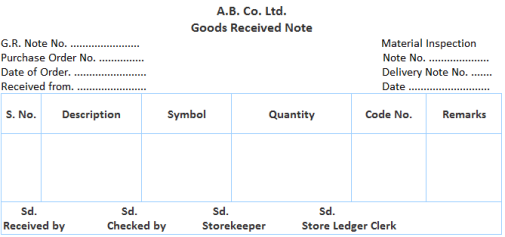
Damage/Shortage/Excess Report
This report is prepared by the receiving section of the stores department on opening the packages and comparing the actual materials received and materials ordered for with the help of the purchase order. Payment to the supplier of materials has to be adjusted according to this document. The proforma of this report is as follows:
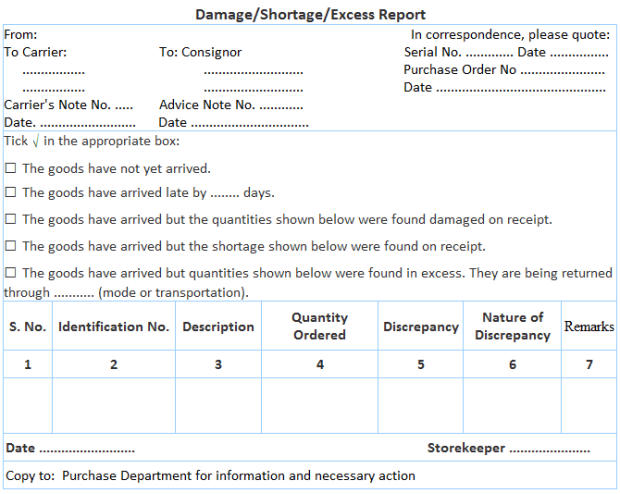
Storage:
Typically, a store has a few processes and a space for storage.
The main processes of store are
In a manufacturing organization, this process of receiving, keeping in custody, and issuing forms a cyclic process which runs on a continuous basis. The organizational set up of the store depends upon the requirements of the organization and is to be tailor made to meet the specific needs of the organization.
Main Processes of a store
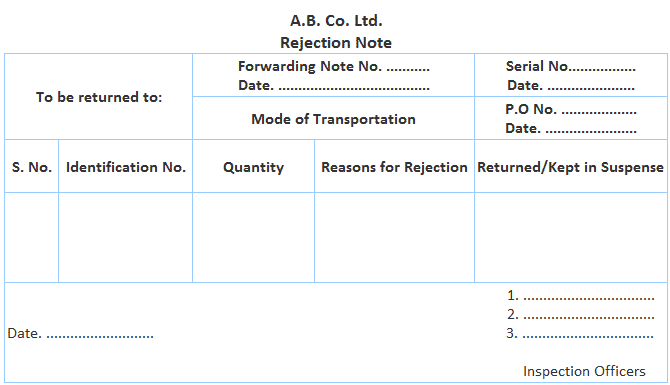
An efficient stores management has normally the following main objectives.
Classification of stores
Stores are classified basically in the following broad categories.
Examples are fuels store, chemicals store, tools store, raw materials store, spare parts store, equipment store, refractory store, electric store, explosives store, and finished goods store etc.
b. Physical stores – Physically stores can be centralized stores or decentralized stores. These stores are named based on the size and location of the store. Examples are central store, sub store, department store, site store, transit stores, receipt store, intermediate store, open yard store, and covered store etc.
c. Stores are also classified by naming them after the departments to which they serve.
Examples are construction stores, operation stores, rolling mill stores, blast furnace stores, and steel melting shop stores etc.
Advantages.
Disadvantages
Functions of a store
Store personnel are responsible for carrying out the following functions.
Delivery
Record Keeping
One of the main parts of accounting is recordkeeping or bookkeeping. Recordkeeping is the process of recording transactions and events in an accounting system. Since the principles of accounting rely on accurate and thorough records, record keeping is the foundation accounting.
Accounting is used to identify events that need to be recorded, recording the transactions of these events, and communicating the effects of these transactions with people inside and outside of the company. As you can see, record keeping is only a small part of the broader definition of accounting.
Record Keeping using excel
Step 1: Start with a bookkeeping Excel sheet template.
The template is separated into three parts:
Step 2: Customize the chart of accounts within your template.
Customize the chart of accounts, the chart of accounts sheet will serve as your point of reference—reminding you how to categorize different transactions.
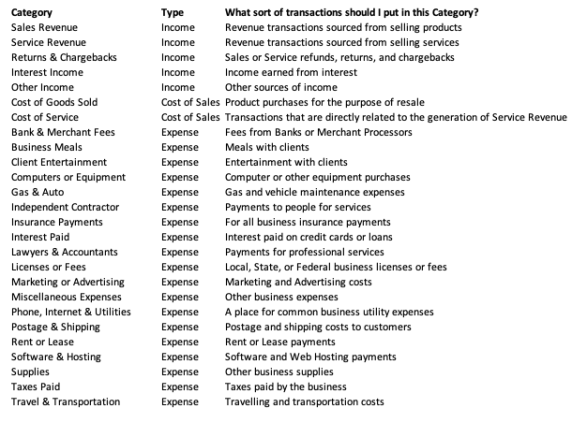
As the figure displays, make a list of every type of expense or income your business uses, and create an account type for each. However, to keep your accounts in Excel, each account should be categorized as one of the following:
Step 3: Customize the income statement sheet.
After customizing the chart of accounts, next work on customizing your income statement sheet. As shown in the figure enter the information from your chart of accounts making sure to include all accounts, but keeping them separated according to whether they’re income, expenses, or COGS.
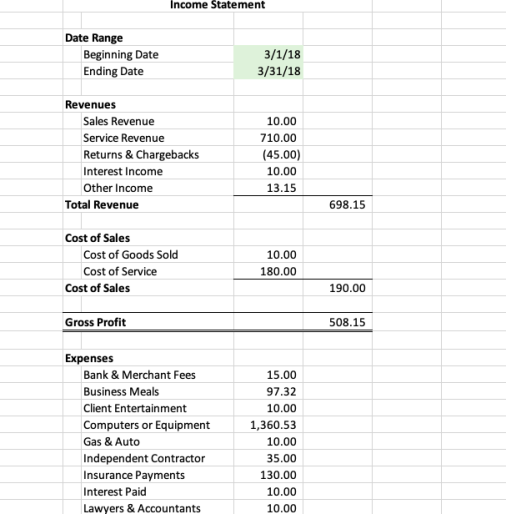
After editing the income statement Excel bookkeeping sheet, make sure to duplicate this sheet (if your template only has one). In order to generate monthly income statements, you’ll need separate sheets for each month. Make 12 copies of the original income statement, one for each month in the year—don’t forget to label each one and enter the date range in the appropriate cell.

Step 4. Add a sheet for tracking invoices.
When you enter income from paid invoices into your transactions sheet, include the invoice number. By doing this, you can cross-reference it to avoid errors like forgetting to enter invoice payments, or entering the same payments twice. It’s much easier to cross-reference if you’ve got a separate sheet to track your invoices.
You can add a tab within your bookkeeping Excel document, or, once again, download an invoice tracking Excel template. If you download a template, you can copy and paste the contents into a new sheet within your master bookkeeping Excel document.
If you want to add an invoice tracking sheet, keep this sheet next to your transactions sheet within the Excel document—this will make it easier to check for reference.
Step 5. Add a sheet for projecting cash flow.
Just like the tracking invoice sheet, you can simply create a new sheet within your master document and paste a cash flow tracking template or, of course, make your own. Download Fundera’s cash flow template here.
Step 6. Save the file to a secure location on your computer.
After you’ve edited and added all of the different sheets within your master Excel bookkeeping document, save the file in a secure location on your computer or drive. Therefore, make sure the file is secure, yet accessible when you need it to perform your day-to-day bookkeeping tasks.
Inputting and Categorizing Transactions
In fact, inputting and categorizing transactions will be a major part of managing your basic bookkeeping in Excel. Every time a transaction takes place, you’ll record and categorize it using the following process:
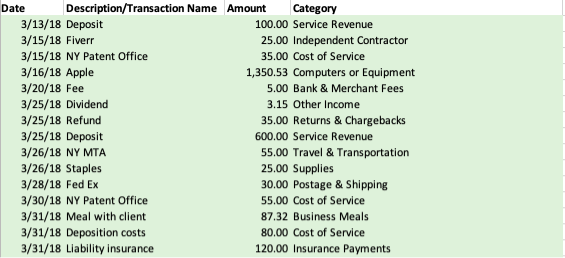
Generating Income Statements
Using this process of inputting transactions, you’ll manage your small business bookkeeping in Excel on a day-to-day basis.
At the end of every month, however, use the income statement sheet to get insights on your income, expenses, and profit.
If you’re not using a template with prebuilt formulas, enter manually to calculate the information to populate your income statement. To do this, review your transactions for the time period and then add totals for each account.
For example, if you have three expense transactions categorized as “Computers or Equipment,” you would take the dollar amounts from those three transactions and add them together—resulting in your “Computers or Equipment” total for the month. It may be helpful to create a separate calculations sheet within your master document where you can track and perform these calculations (the digital equivalent of a scrap piece of paper for calculations).
Through this process, you should be able to calculate and fill in all of the pieces of your income statement—revenues, cost of sales, and expenses.
Once you’ve completed your income statement for the month, make sure to save your Excel bookkeeping file.
Decide to save a separate file on your computer with the income statement for the month—this will be especially helpful for an accountant to reference when it comes to business taxes or other financial planning.
ERP Software
Enterprise resource planning (ERP) is a process used by companies to manage and integrate the important parts of their businesses.
Many ERP software applications are important to companies because they help them implement resource planning by integrating all of the processes needed to run their companies with a single system.
An ERP software system can also integrate planning, purchasing inventory, sales, marketing, finance, human resources, and more.
Features
Benefits
4. Inventory Control
ABC analysis is a system for inventory control used throughout materials and distribution management. It is also sometimes referred to as selective inventory control, or SIC.

However, in terms of their consumption value B and C would make up on 20 per cent of the value combined, with C the least, perhaps split at 15 per cent and 5 per cent respectively. The percentages will vary based on a distributor’s unique inventory control needs.
This means that ABC analysis conforms with the Pareto principle which states that items that account for a large proportion of the overall value are small in number and that items with a low overall value are high in number.
Uses and Applications
Example a warehouse or factory store might choose to count A items, of high worth once a quarter, but B items only two times a year with and C items only counted once.
EOQ
Economic order quantity (EOQ) is the ideal order quantity a company should purchase to minimize inventory costs such as holding costs, shortage costs, and order costs.
This production-scheduling model was developed in 1913 by Ford W. Harris and has been refined over time.
The formula assumes that demand, ordering, and holding costs all remain constant.
Features
Formula and Calculation of Economic Order Quantity (EOQ)

Where
Q= EOQ units
D = Demand in units
S = order cost
H = holding cost
Example
A retail clothing shop carries a line of men’s jeans, and the shop sells 1,000 pairs of jeans each year. It costs the company $5 per year to hold a pair of jeans in inventory, and the fixed cost to place an order is $2.
The EOQ formula is the square root of (2 x 1,000 pairs x $2 order cost) / ($5 holding cost) or 28.3 with rounding. The ideal order size to minimize costs and meet customer demand is slightly more than 28 pairs of jeans. A more complex portion of the EOQ formula provides the reorder point.
Limitations
Key Takeaways:
2. The quality of the product manufactured by the organization depends upon the quality of the materials used to manufacture that product.
3. In case of fluctuating demands, there can be uncertainties in supply as well. This can be overcome by maintaining the proper quantity in inventory of short supply materials at proper time.
4. Requirement’s planning is based on correct forecasting of sales and demand of the products in the market.
5. In small and medium-sized manufacturing concerns, functions of receipt and inspection of materials are to be performed by the stores department or the store-keeper.
6. It is the prime book used for the purpose of store accounting and keeps a date-wise record of the materials received in the stores.
7. Recordkeeping is the process of recording transactions and events in an accounting system
8. In fact, inputting and categorizing transactions will be a major part of managing your basic bookkeeping in Excel
9. Enterprise resource planning (ERP) is a process used by companies to manage and integrate the important parts of their businesses.
10. ABC analysis is a system for inventory control used throughout materials and distribution management
11. Economic order quantity (EOQ) is the ideal order quantity a company should purchase to minimize inventory costs such as holding costs, shortage costs, and order costs.
Fleet Management
A fleet management system is a bundled combination of hardware and software that includes three elements:
Different FMSs record different data. Those with sensors installed into a vehicle’s engine will receive more comprehensive data about the engine status than plug-and-go dashboard devices.
The best FMSs come with active data trackers rather passive ones. This means the data sent by an FMS might refresh as often as every few seconds or as rarely as every ten minutes. A passive tracker collects data on the go but only transfers it to the software later. Near-real-time data updates are essential for a truly effective FMS, so fleet managers can react quickly to important updates, such as late deliveries, or vehicle faults. Some FMSs may even be operated using smart phone apps, making it even easier for managers to respond to situations.
Operation
Benefits of Fleet Management
The benefits of fleet management are multi-fold. Namely, effective fleet management yields fuel savings, increases productivity, and improves customer service.
Fleet management reduces fuel costs–
Telematics solutions for fleet management also increase productivity. Robust telematics software features enhance productivity by helping you gauge maintenance, reduce idle time, downsize your fleet, improve your tracking and routing, monitor safety, and improve employee efficiency. One of the best ways that telematics solutions make fleets more productive is in tracking maintenance.
e. Fleet management improves customer satisfaction– You can use fleet management to improve customer satisfaction, especially with the aid of a GPS tracking solution. Your tracking solution will help ensure driver compliance to routes and schedules to avoid missing or delaying a delivery or appointment.
Productivity Studies
Several fleet experts offered insight to some key elements of what makes for a productive fleet operation.
Utilizing Telematics
One of the most useful tools fleets have available to enhance their productivity is telematics. Tracking drivers is a fundamental component of telematics technology, but being able to break down and assess the bountiful data that it also compiles and turning it into actionable concepts is key for a fleet looking to improve productivity.
Factoring Fuel
Fuel spend is the highest cost center for fleets, and having a better perspective into monitoring this category can also lead to benefits leading to a more productive fleet.
Establishing a fuel program and tracking fuel expenses by assigning a company card for vehicles will help cut down on discrepancies from cash purchases, which can give fleet managers insight into how much is being spent from fueling. Having a clear picture of this can identify where overspending can exist, to which fleets can plan accordingly and adjust.
In another aspect related to fuel: vehicle fuel economy has also impacted acquisition, with more fleets looking to right size to improve productivity. By converting to a fleet of vehicles with better MPG, or implementing vehicles more appropriately suited for the fleet’s needs, fuel benefits can be realized.
Maintenance and Replacement
Having an effective maintenance program will also help lay the foundations of a productive fleet.
Being aware of fleet maintenance needs and when to cycle out older vehicles should help fleets have a more properly maintained portfolio, and will thusly make them more productive.
Layers of Safety
Being better prepared to focus on safety will also help in terms of productivity. If a fleet experiences problems with driver crashes, this can open a window to myriad issues that will significantly hinder fleets productivity.
Handling the Data
But with all these categories that fleets need to consider, having a fleet management company, or other third-party vendor, help the fleet assess the abundant data will further contribute to improved productivity as that will be one less thing on their plate that needs to be addressed.
6.Equipment Down Time
Equipment downtime refers to the amount of time that equipment is not operating, whether that’s a result of unplanned equipment failure (like a fault or broken part) or planned downtime (like necessary downtime for preventive maintenance). Typically, the term “equipment downtime” refers to unexpected downtime that accumulates any time the production process stops.
Calculate equipment downtime
The term “equipment downtime” can apply to any event that halts manufacturing, it’s important for an organization to first figure out what kind of downtime they want to calculate.
For example, let’s say a factory has some particular problems with machines faulting out. They’ve identified that this is the main portion of their downtime, making it the most important variety of downtime for them to track.
One way to calculate the cost of equipment downtime is to look at the loss of revenue over downtime periods.
We can do this by looking at how many products are produced in a certain time period (per hour) against the amount of money made from each product. Then, we measure these numbers against how much downtime has occurred.
A facility can reduce equipment downtime by:
Benefits of tracking equipment downtime
Sizing
Sizing is a for project planning, ensuring that plans and activities are relevant and that resources are properly used and allocated.
Matching are algorithms used to solve problems.
The problem arises when the design does not match requirements. Matching algorithms are used in areas such as scheduling, planning and pairing.
Site Layout and Planning
A site layout plan shows a detailed layout of the whole site and the relationship of the proposed works with the boundary of the property, nearby roads and neighboring buildings.
Most applications should include an existing site layout plan and a proposed site layout plan. For simple applications the existing and proposed site can be combined and shown on one plan so long as what is existing, what is proposed and what is to be demolished is highlighted and annotated clearly.
Site layout plans should:
Safety Measures on Construction Sites
Working on a construction site is the dangerous occupation. Some of the potential hazards that construction workers face every day include:
Construction workers are particularly exposed to high-risk environments that pose dangers which need to be addressed.
Here are the top construction site safety procedures you should have in place for construction sites:
Analyze Your Worksite or Worksites
Regularly analyze your work site to identify any potential hazards and come up with an effective way or plan to eliminate them. Be aware of the main potential hazards in construction sites:
If workers are carrying out their work without the proper protective equipment, identify the problem and let them know. If workers are struggling to complete certain tasks safely, prioritize on the specific issue in your training program.
Check Equipment, Tools and Machines
Before any work commences, you should always check construction equipment, tools and machines in the construction site to ensure they’re safe for use. For instance, conducting proper planning and staging before starting the day ensures that employees have the right tools and equipment they need for their work.
Site Security
Ensure proper construction site security. You should have security measures in place that restrict access to the work site outside of working hours to protect workers or any other person from potential construction hazards. Strict safety and security protocols must always be followed.
Entry and Exit Points
Construction sites must also have separate entry and exit points for vehicle access and heavy machinery to ensure safety at high-traffic areas in the construction site.
Develop a Simple but Effective Training Plan
Based on worksite analysis, develop a simple training plan for your workers. It’s advisable to have more than one category. E.g.
Your training plan should prioritize on the most common mistakes, safety risks and incidents that you’ve noted in a specific area. The training program should be simple but effective.
Environmental Conditions
Let your workers know the right time to work and when to stop working due to environmental conditions. Extreme weather conditions can easily cause safety hazards in construction sites.
Key Takeaways:
References:
1.Construction Project Management 3rd Edition, by KK Chitkara
2. Site Planning, Third Edition by Kevin Lynch
3. Managing Global Software Projects by Gopalaswamy Ramesh